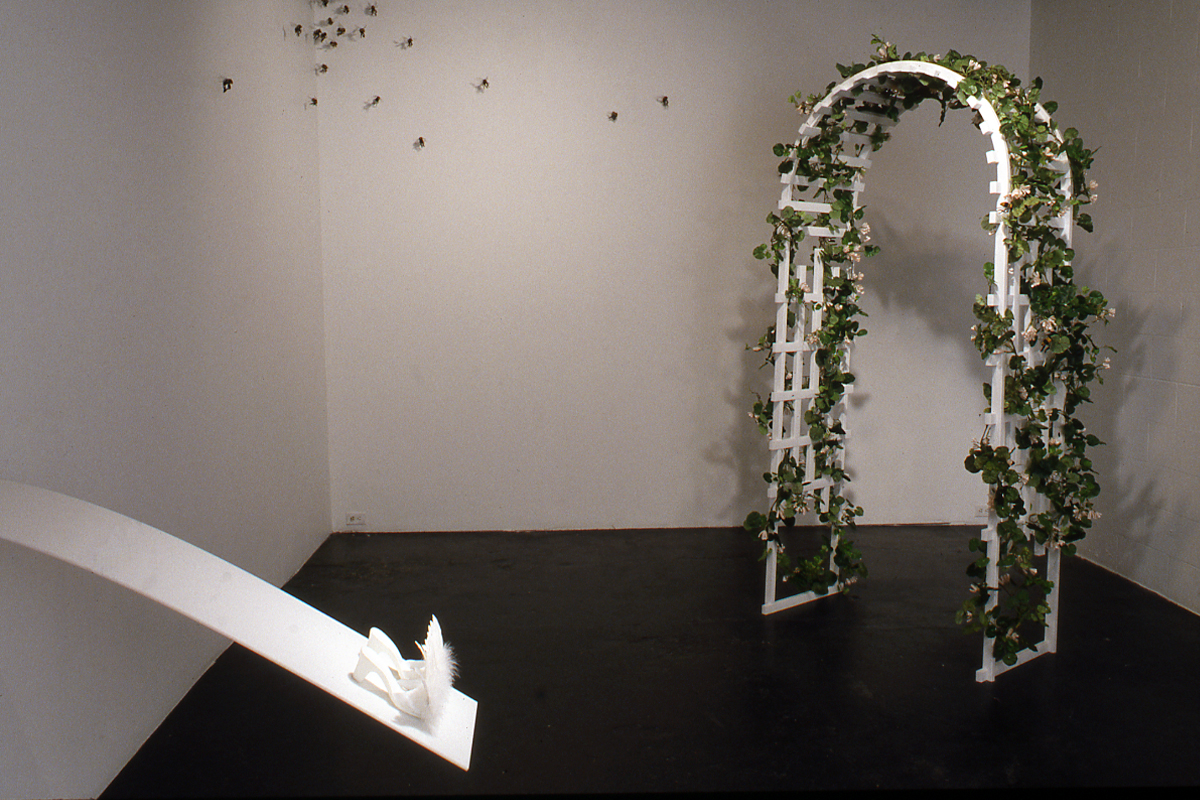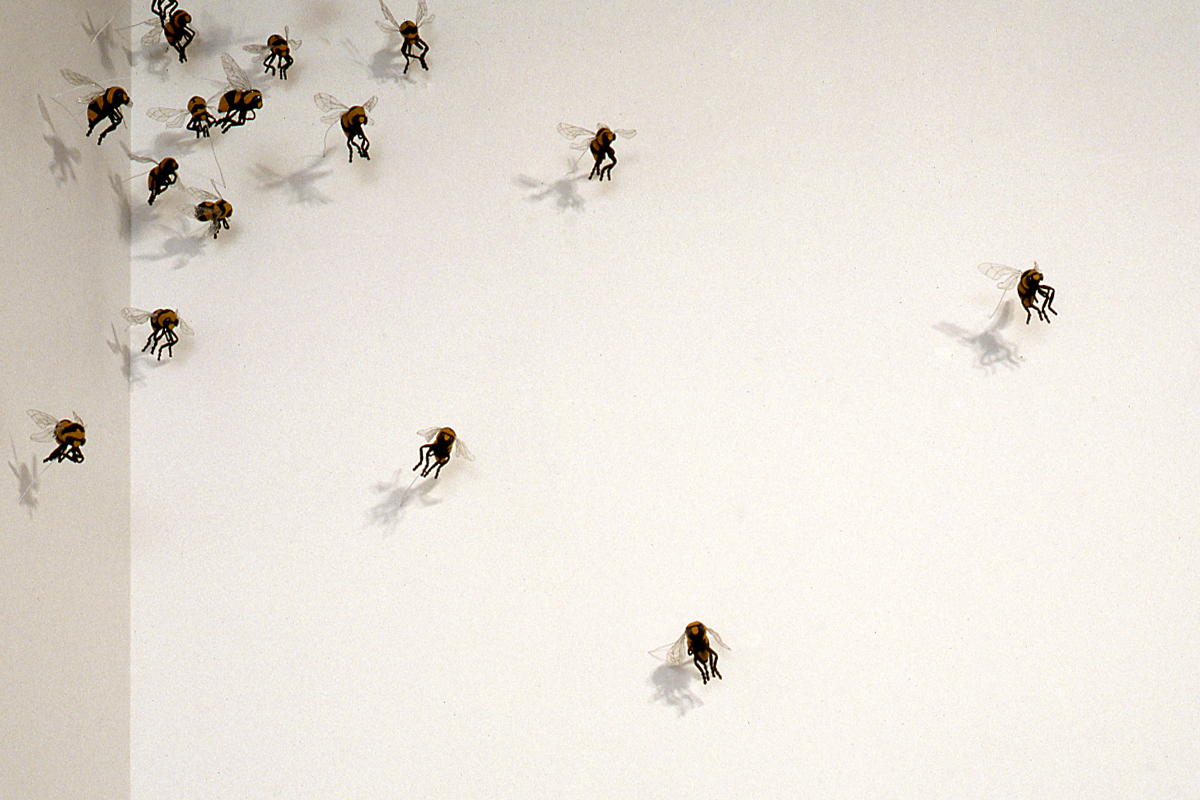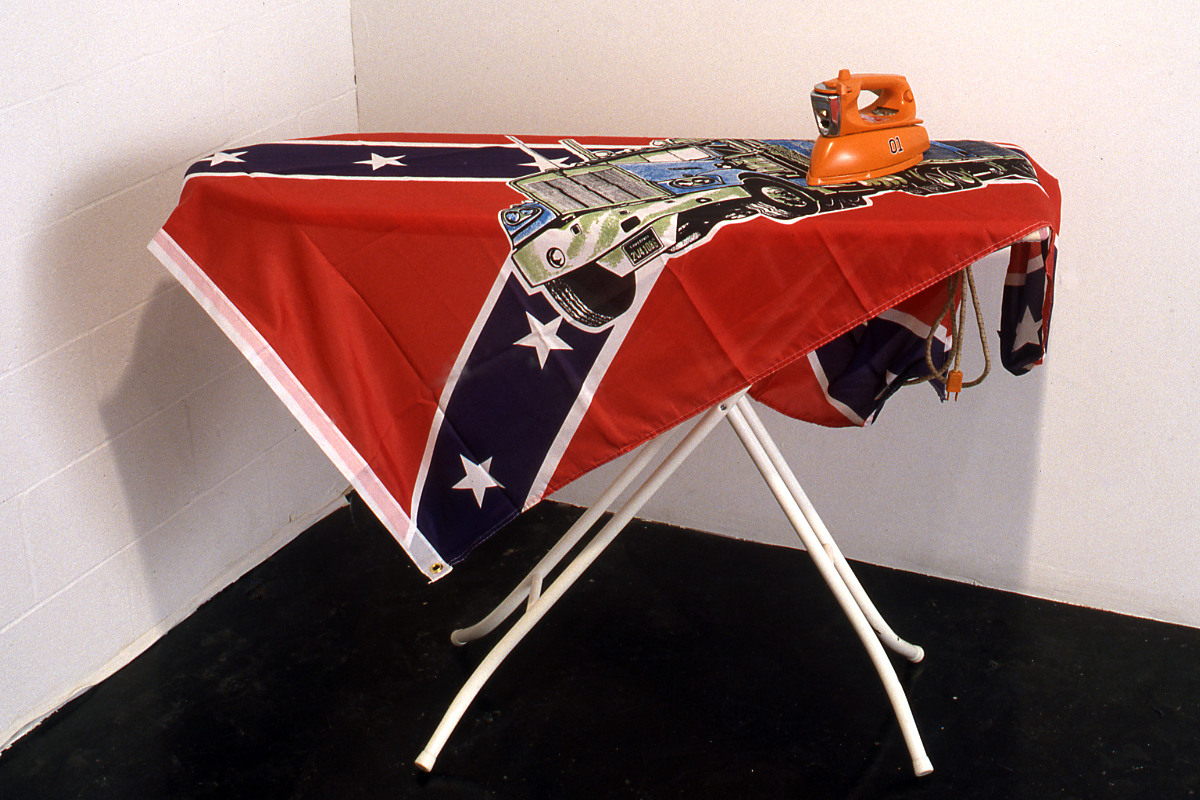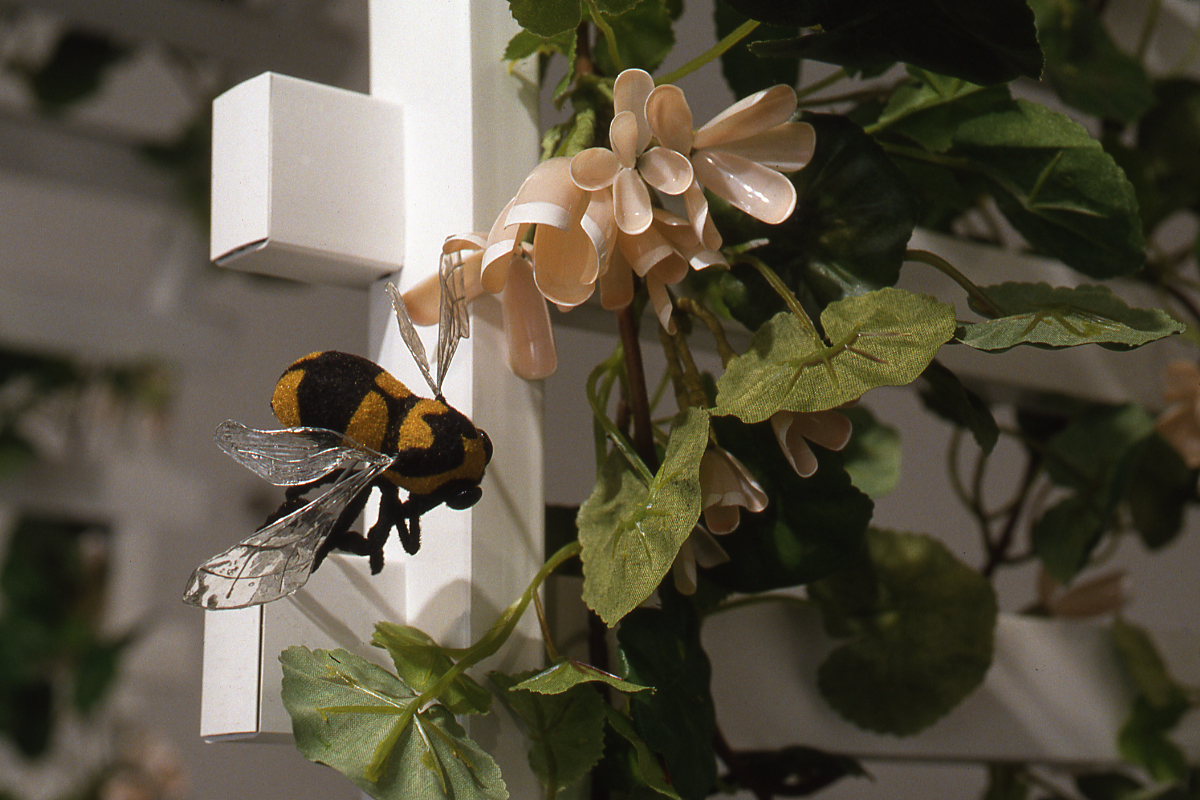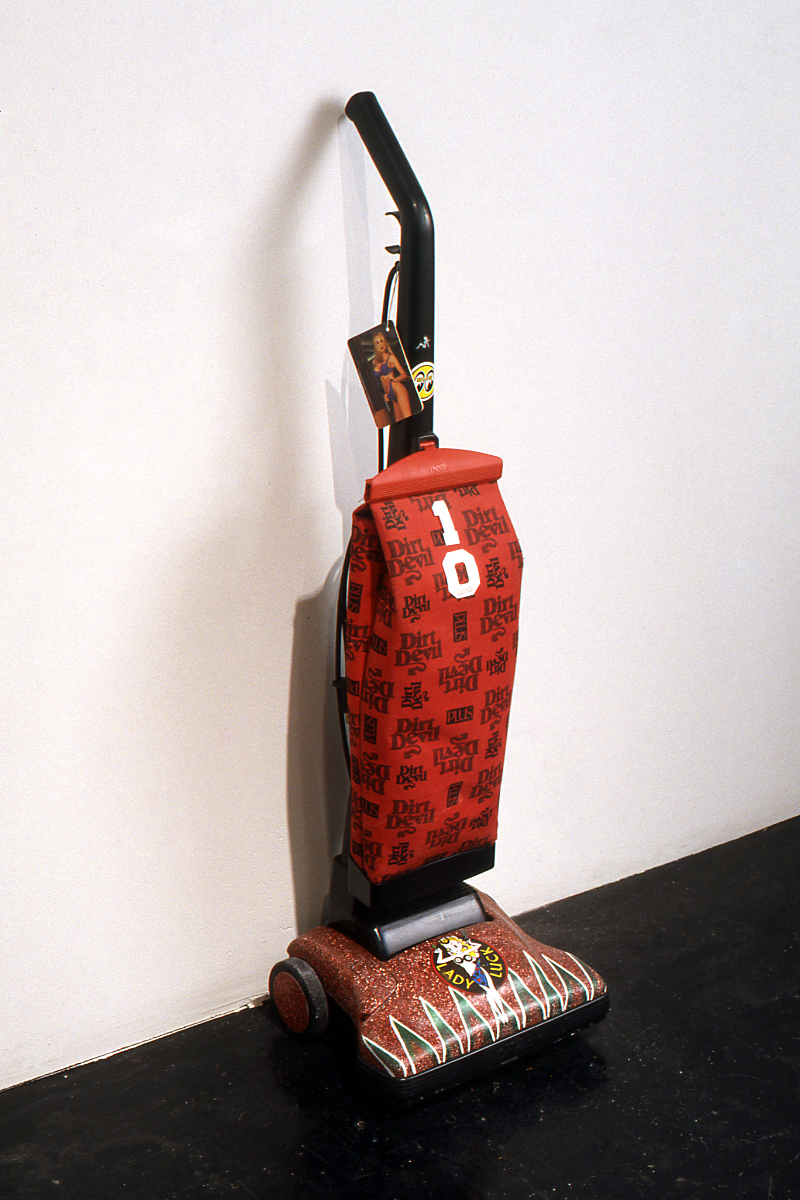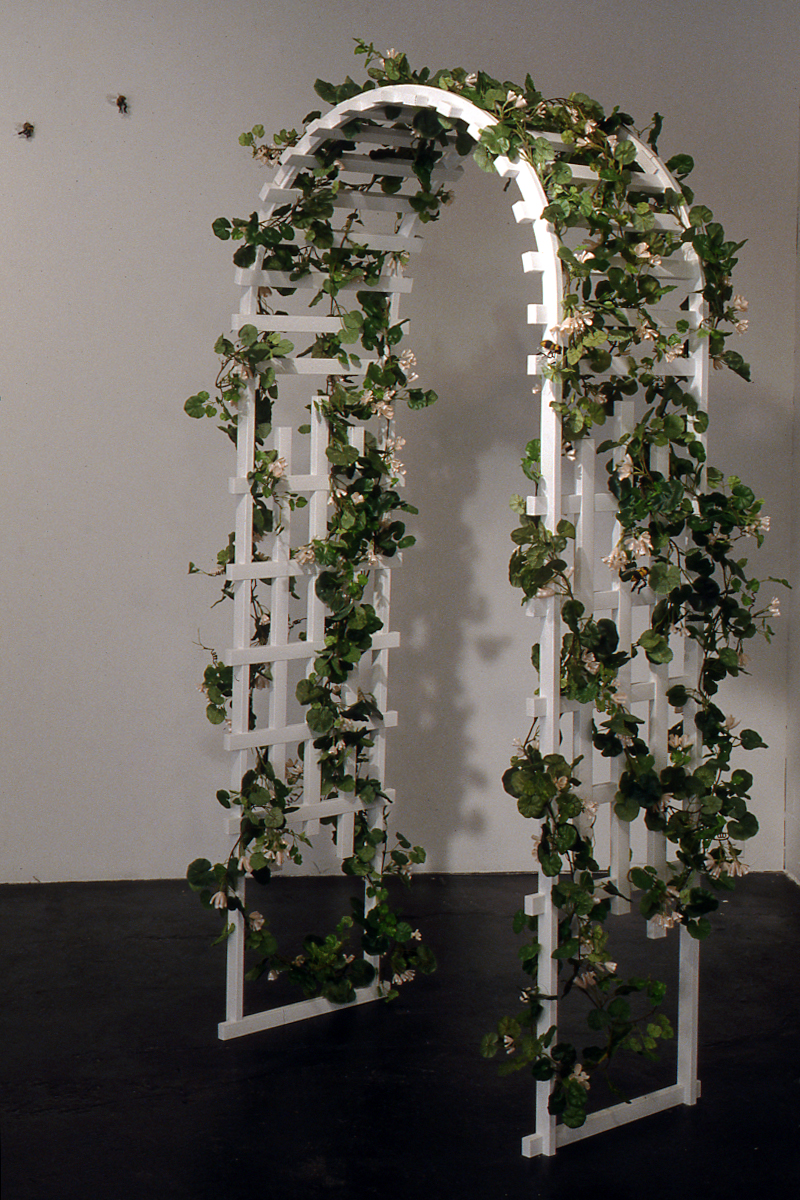Scratch and Leah Modigliani is a uni-monikered artist who reverse-engineers notions of gender through a kaleidoscopic gaze of late 1960s car culture and domestic appliances. Ads are appropriate raw material for Scratch who is as media-savvy as the medium he folds, spindles, mutilates, and silk-screens. He is a marketer, or to use the grating argot of Fast Company, he is a "brand"; his artwork "brand-extensions." He weaves self-reflection with self-promotion, but ensures that one never supersedes the other. It is slick revisionist history with a stingray tail. His work evokes the shiny, accessible aesthetic of Wallpaper, (subtitled The Stuff That Surrounds Us), a magazine that glorifies a kind of hipster-capitalism, a so-called "affluenza," that manages to insulate readers from a [succulent] irony: the more stuff you surround yourself with, the more you become a prisoner of desire. Scratch's sloganeering confronts this unabated material yearning: "You Can't Buy Cool." He sells ideas, not $3,000 couches.
A Lego bricoleur, Scratch looks no further than the kitchen, the garage, and the magazine rack to construct objets d'art that traffic in irony and consumer fetish. He flirts with the media's cherished icons of masculinity and femininity -- hot rods and spontaneity, homemaking and responsibility. In doing so he treats bipolar sexualities like little plastic bricks, connecting them so tightly that the seams vanish. His customized kitschy-kitchen appliances (a pinstriped oven; an STP clothes iron), silk-screens and collages [negotiate imposed ideals of sexual stereotyping in advertising, creating what one might cheekily dub "hermaphroditic pop-art."
Scratch graduated from Emily Carr Institute of Art and Design in 1995 and worked in the arts in Vancouver until moving to Ottawa in 1999. While in Vancouver he ran a gallery out of his apartment for two years and was part of the V8 Collective exhibition at Helen Pitt Gallery. He is married and currently expecting his first child.
Leah Modigliani is an artist who works with the materials of stereotypic gender construction to create sculpture that questions our expectations of art objects and fashion. Rather than simply dissecting fashion magazines like Glamour or Seventeen, she has ripped a page or two from a fairy tale. Through this unique mix of fairy tale and fashion, Modigliani crafts complex creations that facilitate multiple interpretations about cultural expectations and transformative rituals.
The first item of Modigliani's interlinking sculptures is Pretty Bride Slippers. It is a plank of white plexiglass board that appears to erupt from the wall. It sags toward the ground and presents an urgent, Peter Pan choice for the slippers; they must either jump and fly or plunge to their death.
With Kiss Nails, Modigliani takes gender "construction" literally. The sculpture is a trellis that beckons one to enter a rite of passage. If the slippers are contemplating a leap of faith, then the trellis offers a direction to move toward or away from. And despite an appearance of traditionality, closer inspection reveals curious inconsistencies-the vines have been stripped of their original pink geraniums and replaced with thousands of false fingernails. A comment on artifice perhaps, or an evocation of the pain of the removal of nails from human hands.
Modigliani's sculpture reveals tenuous links that the viewer must uncover for themselves. [For those seeking interpretive guidance, consider Modigliani's interest in the Bildungsroman, a genre of German storytelling where the protagonist passes through various stages of action or consciousness before arriving at a heightened critical awareness. The interlinking sculptures work together like stages of a Bildungsroman, offering the viewer an implied narrative about gender construction and social expectation.
The constraints of domesticity and responsibility examined here are clear, but both artists have also shown that living in an era lacking in clear societal guidelines is no less difficult to navigate.
Leah Modigliani is a Canadian artist who lives and works in San Francisco. Her sculptures investigate gender and identity stereotypes as manifested in popular objects and images. She received a B.F.A. form Concordia University in 1993 and an M.F.A. from the San Francisco Art Institute in 1997. She has exhibited her work extensively in Canada and the United States.
A Lego bricoleur, Scratch looks no further than the kitchen, the garage, and the magazine rack to construct objets d'art that traffic in irony and consumer fetish. He flirts with the media's cherished icons of masculinity and femininity -- hot rods and spontaneity, homemaking and responsibility. In doing so he treats bipolar sexualities like little plastic bricks, connecting them so tightly that the seams vanish. His customized kitschy-kitchen appliances (a pinstriped oven; an STP clothes iron), silk-screens and collages [negotiate imposed ideals of sexual stereotyping in advertising, creating what one might cheekily dub "hermaphroditic pop-art."
Scratch graduated from Emily Carr Institute of Art and Design in 1995 and worked in the arts in Vancouver until moving to Ottawa in 1999. While in Vancouver he ran a gallery out of his apartment for two years and was part of the V8 Collective exhibition at Helen Pitt Gallery. He is married and currently expecting his first child.
Leah Modigliani is an artist who works with the materials of stereotypic gender construction to create sculpture that questions our expectations of art objects and fashion. Rather than simply dissecting fashion magazines like Glamour or Seventeen, she has ripped a page or two from a fairy tale. Through this unique mix of fairy tale and fashion, Modigliani crafts complex creations that facilitate multiple interpretations about cultural expectations and transformative rituals.
The first item of Modigliani's interlinking sculptures is Pretty Bride Slippers. It is a plank of white plexiglass board that appears to erupt from the wall. It sags toward the ground and presents an urgent, Peter Pan choice for the slippers; they must either jump and fly or plunge to their death.
With Kiss Nails, Modigliani takes gender "construction" literally. The sculpture is a trellis that beckons one to enter a rite of passage. If the slippers are contemplating a leap of faith, then the trellis offers a direction to move toward or away from. And despite an appearance of traditionality, closer inspection reveals curious inconsistencies-the vines have been stripped of their original pink geraniums and replaced with thousands of false fingernails. A comment on artifice perhaps, or an evocation of the pain of the removal of nails from human hands.
Modigliani's sculpture reveals tenuous links that the viewer must uncover for themselves. [For those seeking interpretive guidance, consider Modigliani's interest in the Bildungsroman, a genre of German storytelling where the protagonist passes through various stages of action or consciousness before arriving at a heightened critical awareness. The interlinking sculptures work together like stages of a Bildungsroman, offering the viewer an implied narrative about gender construction and social expectation.
The constraints of domesticity and responsibility examined here are clear, but both artists have also shown that living in an era lacking in clear societal guidelines is no less difficult to navigate.
Leah Modigliani is a Canadian artist who lives and works in San Francisco. Her sculptures investigate gender and identity stereotypes as manifested in popular objects and images. She received a B.F.A. form Concordia University in 1993 and an M.F.A. from the San Francisco Art Institute in 1997. She has exhibited her work extensively in Canada and the United States.
Ryan Bigge
